This painting is a perfect example of lyrical abstraction and a choice painting out of the best period of Vlerick's career.
Pierre Vlerick’s work shows some resemblance to Willem de Kooning’s. While the Dutch American was famous for the wild manner in which he treated his canvas, Pierre Vlerick showed some more restraint, but making a painting was in any case a slow process of stopping and starting and revising. His exploration is meant to result in a correct proportion of colour fields and streaks, often applied layer upon layer. All his colors have a luminous intensity. It was mainly Bonnard’s colorful work that inspired Vlerick to compose his own singular range of colors of slightly tingling yellows, greens, oranges and bits of blue here and there. Abstraction is emphasized by his use of color. Colors not associated with objects from daily life often dominate the composition: purple, for instance. This is the basis for his continuing abstraction, ending up as color fields combined with organic elements depicted with the vaguest of contours.
Though both artists create a very metropolitan, say even worldly art, their work evokes nature. De Kooning has been called a master of ‘abstract landscape’. The structure of Vlerick’s works, too, is very vegetable and organic. No wonder he referred to his paintings as his ‘gardens’. Neither artist allowed his garden to remain empty: de Kooning created a female figure looking like a cross between a floozy and the mother goddess. Vlerick imagined a woman who is enjoying her body. Vlerick’s approach to abstract art is the same as de Kooning’s; they refuse to paint in a figurative manner, yet at the same time do not wish to renounce referring to reality.
De Kooning once put it very accurately during an interview when he conceded that painting the human figure any longer was absurd(in the post-war period), but also stated that it would be even more absurd not to do it. The only way out of this ambiguous dilemma is the deconstruction of the human figure. Not in order to reject it, but to show it in all its fragility.














